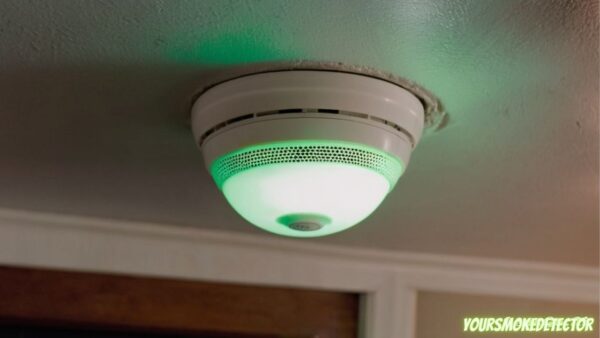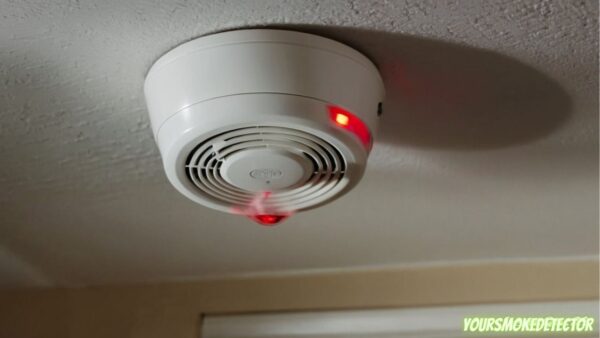A Smoke Detector Blinking Red No Sound can be a puzzling predicament for many homeowners.
The silent, yet persistent red flash may leave you wondering about its significance and the necessary course of action.
This article aims to shed light on the mystery surrounding a Smoke Detector Blinking Red No Sound situation, providing you with the requisite knowledge to handle this issue efficiently.
Armed with this understanding, you’ll be able to maintain the utmost safety in your home, even when your Smoke Detector is Blinking Red but there’s No Sound.
Smoke Detector Blinking Red No Sound

1. Battery Replacement Needed
Cause
A smoke detector that flashes a red light without producing any sound is typically signaling a need for battery replacement.
This is a built-in feature designed to alert homeowners of a low battery condition.
It’s crucial to not ignore this signal as a powerless smoke detector can’t provide the necessary protection in case of a fire.
Solution
To rectify the situation, prompt battery replacement is necessary. Firstly, turn off the device.
Then, carefully open the battery compartment and remove the old battery. After this, insert a new, high-quality battery, ensuring the correct orientation.
Once the new battery is in place, close the compartment and turn on the device. The flashing red light should stop if the problem was indeed a low battery.
Always test your smoke detector after replacing the battery to confirm that it’s working correctly.
2. Faulty Detector Circuit

Cause
The cause of a faulty detector circuit can often be traced back to issues such as component failure, improper installation, or wear and tear with age.
When key components falter, the entire system may fail to function correctly, even leading to false positives or no readings at all.
Component failure, improper installation, and wear and tear are common culprits behind a failing detector circuit.
Solution
Addressing a faulty detector circuit involves a systematic approach of identifying and rectifying the underlying issue.
This could range from replacing failed components to correcting installation errors.
Regular maintenance checks, timely replacement of worn-out parts, and professional installation can significantly reduce the chances of a faulty detector circuit.
3. Dust Accumulation Inside Detector
Cause
Dust accumulation inside the detector can severely hinder its operational efficiency.
The particulate matter may interfere with the detector’s sensing mechanism, leading to inaccurate readings or total malfunction.
It’s crucial to understand that dust doesn’t merely block the detector’s aperture; in fact, it can insinuate itself into the internal components and cause damage over time.
Solution
To address this issue, regular maintenance and cleaning of the detector is recommended.
Use a soft brush or compressed air to gently remove the dust without causing internal damage.
For tough accumulations, a specialized cleaning solution for electronics may be used.
4. Interference from External Light
Cause
The interference from external light in visual-based systems is a common predicament.
Unwanted light from sources like the sun or artificial light fixtures can cause a degradation in image quality or completely wash out an image.
This typically happens when the system is not properly shielded or calibrated to handle varying degrees of light intensity.
Solution
To alleviate this issue, employing manual touch adjustments in the system settings can be effective.
For instance, adjusting the system’s exposure settings, incorporating optical filters, or setting up physical shields to block unnecessary light can significantly reduce interference.
Moreover, constant monitoring and recalibration of the system, ensuring it caters to varying light conditions, can also mitigate the impact of external light interference.
5. Inadequate Power Supply
Cause
The issue of inadequate power supply often roots from various factors such as aging infrastructure, overconsumption, or lack of proper maintenance.
This can lead to intermittent power cuts, decreased efficiency, and potential equipment damage.
Aging infrastructure may not be designed to handle the increased demands of modern electrical devices.
Overconsumption can strain the power grid, leading to instability and frequent shutdowns.
Solution
Addressing an inadequate power supply involves proactive measures like regular maintenance, infrastructure upgrades, and conscientious energy usage.
Regular maintenance can identify and prevent potential malfunctions early. Infrastructure upgrades can be implemented to meet the growing demand, improving power delivery and system stability.
6. Smoke Chamber Obstruction
Cause
Smoke chamber obstructions typically result from a buildup of creosote, a byproduct of burning wood.
This accumulation obstructs the proper draft of smoke and can even lead to dangerous chimney fires.
Creosote is the primary cause of smoke chamber obstruction and its accumulation is often due to incomplete combustion or low burning temperatures.
Solution
The most effective solution to smoke chamber obstruction is regular maintenance and cleaning by a certified professional.
This ensures the appropriate removal of creosote, reducing the risk of blockage and fires. Always ensure your chimney is inspected and cleaned regularly by a certified professional to maintain safe and efficient operation.
7. End of Detector Life
Cause
The end of a detector’s life can typically be attributed to several factors including, but not limited to, consistent use over a long period, exposure to harsh environmental conditions, and lack of regular maintenance.
Over time, these elements can lead to degradation of the detector’s components, resulting in reduced accuracy and efficiency.
Solution
To address the end of detector life, it’s recommended to replace the unit with a new one.
However, implementing a regular maintenance schedule and ensuring the device is used and stored as per the manufacturer’s guidelines can significantly extend its lifespan.
It’s also crucial to perform regular checks and replace batteries or individual components as needed.
8. Improper Wiring
Cause
Improper wiring is often the result of unprofessional installation or substandard materials used.
It can also occur when the electrical load exceeds the wiring’s capacity, leading to overheating, short circuits, and potentially, fire hazards.
Solution
Solving this issue involves the replacement or upgrade of the wiring system by a licensed professional.
They can correctly assess the electrical load and install suitable wiring, ensuring safety and functionality.
9. Temperature Fluctuations
Causes
Temperature fluctuations can occur due to a variety of reasons including seasonal changes, geographic locations, and human influence.
The latter is particularly noteworthy as human activities—such as deforestation, burning of fossil fuels, and industrialization—contribute to global warming which, in turn, exacerbates temperature swings.
Key activities like deforestation and industrialization have a significant impact on global temperatures.
Solutions
Addressing temperature fluctuations requires both individual and collective efforts.
On a personal level, individuals can contribute by reducing energy consumption, adopting sustainable practices, and promoting environmental awareness.
On a larger scale, governmental bodies, organizations, and communities need to enforce and adhere to strict environmental policies and regulations.
Promoting sustainable practices and enforcing strict environmental policies are crucial in combating temperature fluctuations.
10. Humidity and Condensation Issues
Cause
High indoor humidity is often caused by excess moisture in the air from activities such as cooking, bathing, and even breathing.
This excess moisture can lead to condensation, especially on cooler surfaces, potentially resulting in mold growth and structural damage.
It’s crucial to understand that damp environments serve as ideal breeding grounds for molds and bacteria, jeopardizing both the structural integrity of buildings and occupants’ health.
Solution
The solution to humidity and condensation issues lies in maintaining an appropriate balance of indoor humidity, typically between 30% and 50%.
This can be achieved by using dehumidifiers or air conditioning units, improving ventilation, especially in areas like the kitchen and bathroom, and using moisture-absorbing materials.
11. Aged or Expired Detector
Cause
Often, when dealing with perishable goods, we tend to lose track of the shelf life, leading to the consumption of expired products.
This can happen due to improper storage, lack of expiry date monitoring, or even the absence of a proper inventory management system.
Such negligence can lead to health risks and unnecessary wastage.
“Negligence in tracking the expiry dates of perishable goods can lead to health risks and wastage.”
Solution
The “Aged or Expired Detector” addresses this issue head on. It’s a tool designed to monitor the shelf life of your items and alert you before they expire.
With manual touch, you can input the required data for each item, and the system will take care of the rest, ensuring that you’re always in the know about the status of your perishables.
“The ‘Aged or Expired Detector’ ensures you’re always informed about the status of your perishables, preventing health hazards and avoiding wastage.”
12. Malfunctioning Sensor
Cause
The most common cause for a malfunctioning sensor can be attributed to physical damage or improper calibration.
It may be due to excessive exposure to harsh environments, such as high temperature or humidity, leading to its deterioration.
Physical damage and improper calibration are the predominant causes of sensor malfunctions.
Solution
Addressing a malfunctioning sensor requires a two-pronged approach – diagnosis and rectification.
Initially, the sensor needs to be examined for any visible damages. If found, it should be replaced. If the damage isn’t physical, recalibration of the sensor might solve the problem.
Routine inspection and timely recalibration often help in mitigating sensor issues.
13. Software Glitches
Cause
Software glitches often occur due to coding errors, inadequate testing, or compatibility issues.
These unanticipated bugs can lead to performance degradation and even cause the software to crash.
They significantly impact user experience and can also have financial implications in the case of business software applications.
“Incorrect code implementation, rushed software releases, and system incompatibility are common causes of software glitches.”
Solution
Addressing software glitches requires a systematic approach, including thorough testing, regular updates, and user feedback implementation.
Comprehensive and rigorous testing helps in identifying and fixing bugs before the software reaches the end-user. Regular updates ensure compatibility with evolving technology and user requirements.
Including user feedback in iterative software, development cycles helps in enhancing overall software performance and usability.
“Adopting robust testing measures, periodic software updates, and integrating user feedback can largely mitigate software glitches.”
14. Interference from Other Electronic Devices
Cause
Electromagnetic interference from other electronic devices can disrupt the normal functioning of your device.
Common culprits include microwaves, cordless phones, and other Wi-Fi-enabled devices that operate on the same frequency band.
These devices may produce electromagnetic fields that can interfere with your device’s ability to maintain a stable connection.
Solution
To mitigate this issue, it is advisable to keep your device away from other electronic appliances.
Try locating your device in a different place, preferably in a central location free from barriers like walls or furniture.
Additionally, consider using devices on different frequency bands to avoid overlap. Regular updates of your device’s firmware can also help to reduce susceptibility to interference.
15. Detector Misalignment
Cause
Detector misalignment, a common issue in various industrial and scientific applications, usually arises due to inadvertent shifts in the detector’s positioning or orientation.
This misalignment can lead to inaccuracies in data readings, resulting in inefficient operation and potential damage to the system.
The most common causes include mechanical vibrations, temperature changes, and improper initial setup.
Solution
Addressing detector misalignment requires thorough diagnostic checks to determine the degree and direction of misalignment.
Once identified, precise adjustments can be made manually to realign the detector correctly. This process might require professional expertise to avoid further complications.
Conclusion
We find that a comprehensive approach to any task not only brings about a markedly improved outcome but also fosters a deeper understanding of the underlying principles.
This holistic approach, coupled with a keen eye for detail, paves the way for solutions that are both innovative and enduring.
Trust in the process, stay committed to your goals, and remember, the journey toward success is just as important as the destination itself.
FAQs
Why is the red light flashing on my smoke detector?
The flashing red light on your smoke detector indicates that it’s in operation and testing itself for functionality.
Why is my smoke detector not making a sound?
Your smoke detector might not make a sound if its batteries are depleted or if there’s an issue with its internal wiring.
Will my smoke detector stop blinking red?
Yes, your smoke detector will stop blinking red once it’s reset or the issue causing the blinking is resolved.
Please note that it’s crucial to regularly check your smoke detector’s functionality to ensure your safety.
First Alert Smoke Detector Green Light Blinking
Blinking Red Light on Smoke Detector
Carbon Monoxide Detector Green Light Stays On
Fire Alarm Randomly Going Off for a Few Seconds
Hard Wired Smoke Detector Red Light Flashing
Hardwired Smoke Alarm Keeps Going Off at Night
How to Silence Smoke Alarm Low Battery
Mains Smoke Alarm Beeping Every 30 Seconds
Why Did My Fire Alarm Randomly Go Off in the Middle of the Night
How Long Will a Smoke Detector Chirping After Changing Battery
Smoke Alarm Keeps Going off Every 10 Minutes
Smoke Detector Flashing Red Every 30 Seconds



